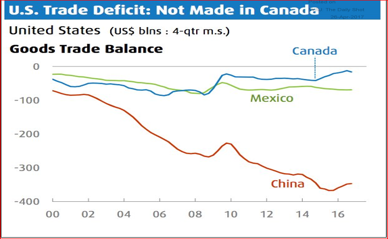President Trump has started his trade war by slapping maximum of 24% countervailing duty on Canadian softwood lumber entering the United States. This is yet another episode in this long-standing dispute with Canada that goes back more than two decades. The crux of the issue is the alleged subsidies provided to the Canadian industry. The vast majority of Canada’s softwood production comes from provincially-controlled lands. The Americans allege that the royalties or stumpage fees are too low and hence are a form of export subsidy. Over the years various dispute–resolution panels have questioned the U. S. argument regarding injury and dumping. In 2004, the International Trade Commission found in Canada’s favor, citing that imports did not harm the U.S. industry.
President Trump chose an easy target in the Canadian softwood exports to start his trade wars. After all, the U.S. trade deficit with Canada is minuscule compared to that of China, so picking on the little kid in the neighborhood is what bullies usually do. (As President Trump has found out, starting a trade war with China is entirely a more difficult and dangerous course to follow).

Given the long legal history involving U.S actions against imported softwood, it is an easy sell on the part of the Trump administration to resurrect the issue. No pun intended, but the Trump administration chose a very “soft” target to start this trade war. In the words of Bob Rae, a former federal parliamentarian,
The punitive tariff he has just imposed on lumber is egregious protectionism. It is intended to protect some U.S. producers and to put some Canadian companies out of business. The federal and provincial governments have an obligation to sustain the Canadian lumber industry through its fifth time of torment since the 1980s. The U.S. has never won a major trade complaint on lumber. They are simply using raw power.[1]
Let’s put this dispute into some economic context.













Leave A Comment